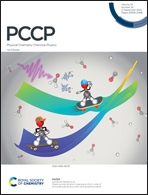First principles study of thermoelectric performance in pristine and binary alloyed monolayers of noble metals†
Abstract
In search of novel thermoelectric materials, we have investigated the thermoelectric performance of freestanding pristine and binary alloyed monolayers of noble metals (viz. Au, Ag, Cu, Pt) in honeycomb morphology using first principles methods based on density functional theory (DFT) and the non-equilibrium Green's function (NEGF) approach. The requisite electron transmission function is calculated using the TranSIESTA code – a module of the SIESTA package, while its phonon counterpart is obtained using the Phonons module of the python package along with the NEGF utility – PHtrans. Transport is explored along both the armchair (ac) and zigzag (zz) directions. Due to greater transverse length of the unit cell, electron and phonon transport is found to be more in the zz-direction. Among the pristine monolayers, Pt is found to exhibit ferromagnetism as well as the highest thermoelectric efficiency ZT ∼ 8 with an external bias of μ = 0.795 eV. However, alloying brings in a characteristic energy gap in the phononic transmission function, which diminishes the (room-temperature) relative phononic conductance to less than 5% in Pt-containing alloys. Also, monolayers of AuAg and AuCu turn semiconducting, with the former yielding a high Seebeck coefficient of 1264.96 μV K−1 at μ ∼ −0.055 eV. Moreover, they exhibit an enhanced ZT near the edges of the band gap, with ZTmax as high as 3.74 and 3.05, respectively. Interestingly, the Pt-containing alloyed monolayers also show a ferromagnetic character and hence, a spin-dependent Seebeck effect. In the CuPt monolayer, the bias μ can be tuned to attain an appreciable charge figure of merit ZcT = 4.80 at μ = 0.58 eV, while a decent spin figure of merit ZsT = 1.43 at μ = 0.56 eV. Instead, the pristine Pt monolayer shows a much better ZsT = 5.45 for a bias of μ = 0.785 eV. Nevertheless, the predicted ZT remains smaller than the corresponding alloyed atomic chains in double zigzag topology.



 Please wait while we load your content...
Please wait while we load your content...